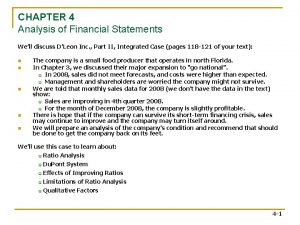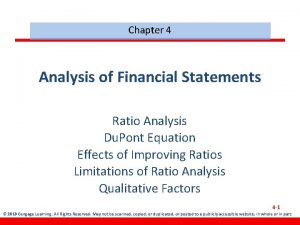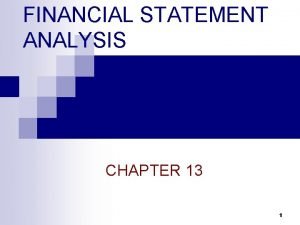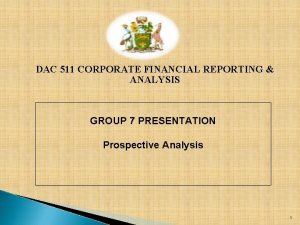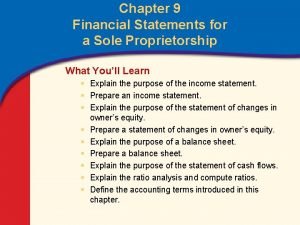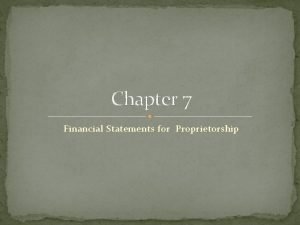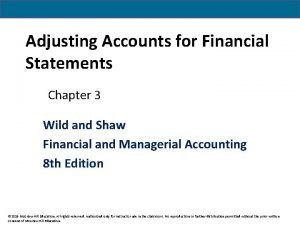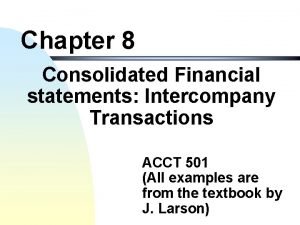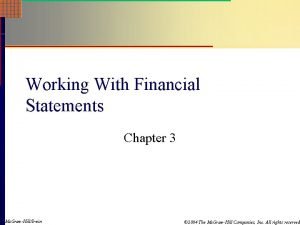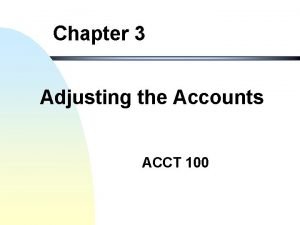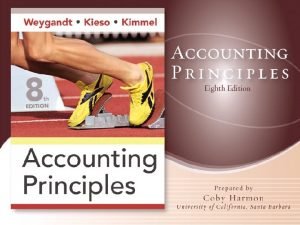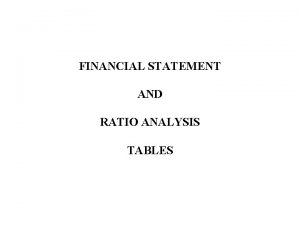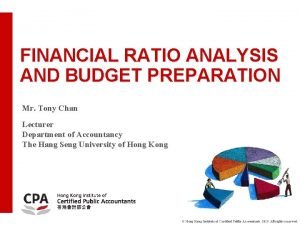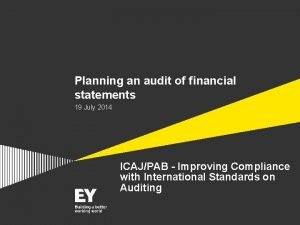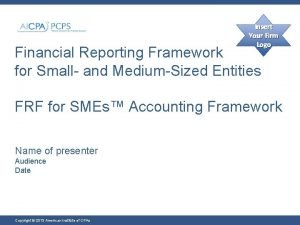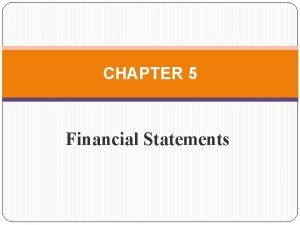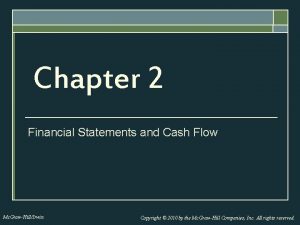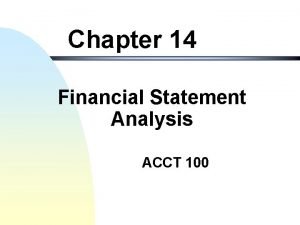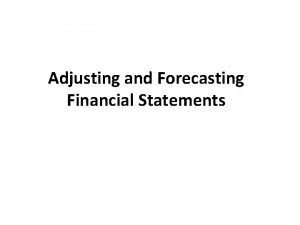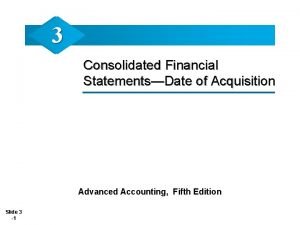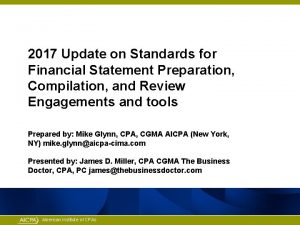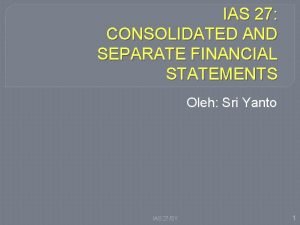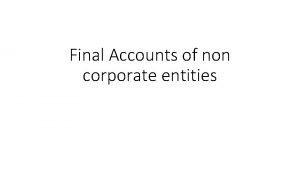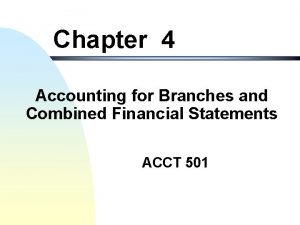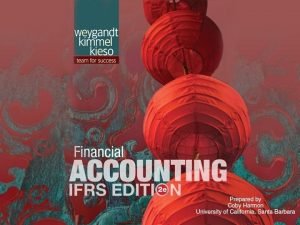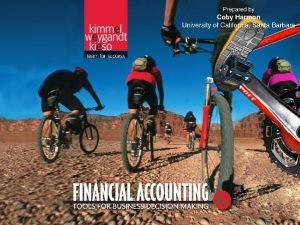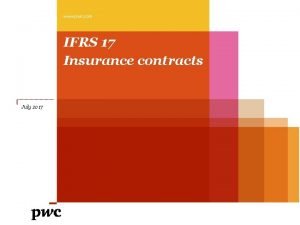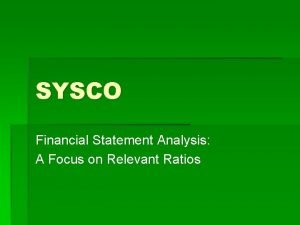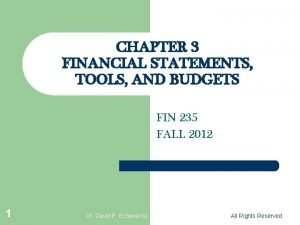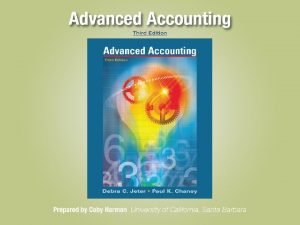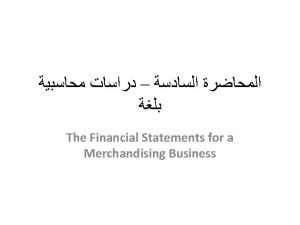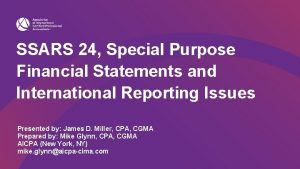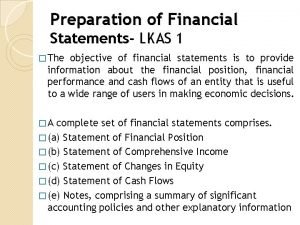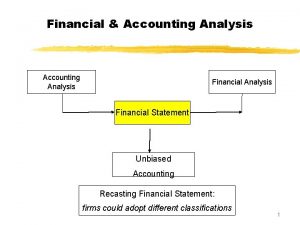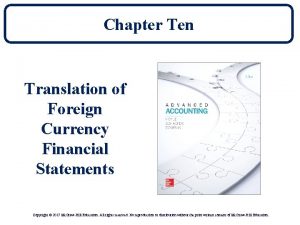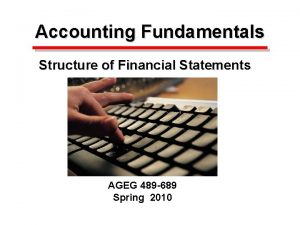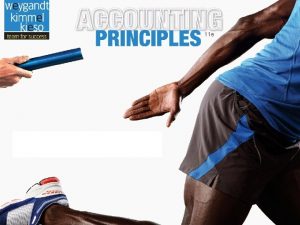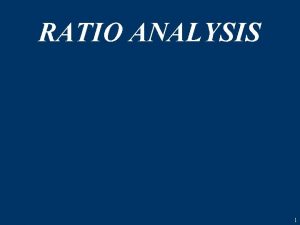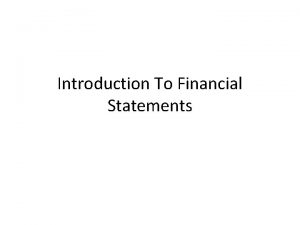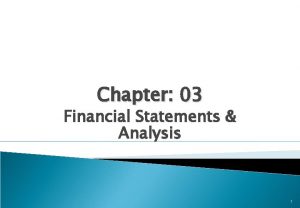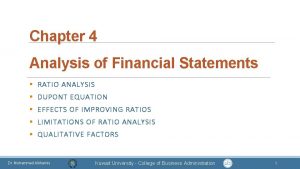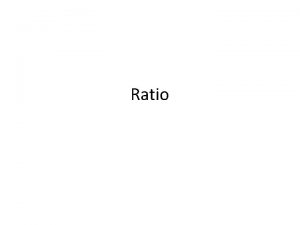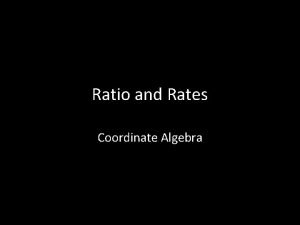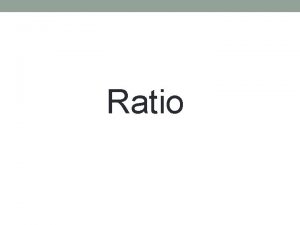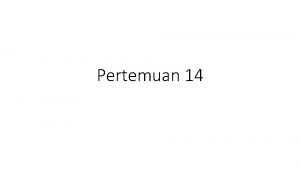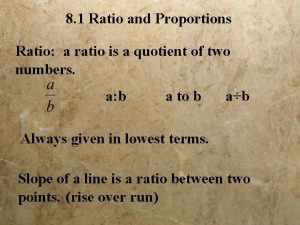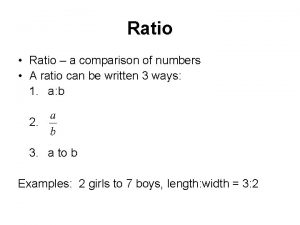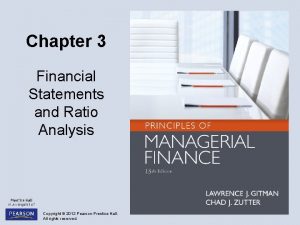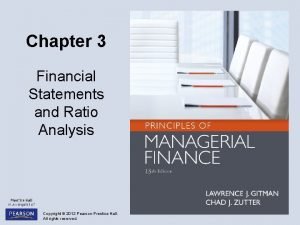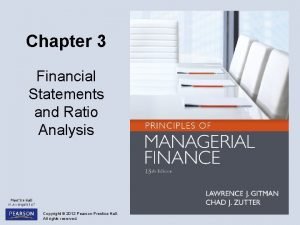Chapter 4 Analysis of Financial Statements RATIO ANALYSIS
















































- Slides: 48

Chapter 4 Analysis of Financial Statements § RATIO ANALYSIS § DUPONT EQUATION § EFFECTS OF IMPROVING RATIOS § LIMITATIONS OF RATIO ANALYSIS § QUALITATIVE FACTORS Dr. Mohammad Alkhamis Kuwait University - College of Business Administration 1

Why are ratios useful? § Ratios standardize numbers and facilitate comparisons. § Ratios are used to highlight weaknesses and strengths. § Ratio comparisons should be made through time and with competitors. § Trend analysis. § Peer (or industry) analysis. Dr. Mohammad Alkhamis Kuwait University - College of Business Administration 2

Five Major Categories of Ratios and the Questions They Answer § Liquidity: Can we make required payments? § Asset management: Right amount of assets vs. sales? § Debt management: Right mix of debt and equity? § Profitability: Do sales prices exceed unit costs, and are sales high enough as reflected in PM, ROE, and ROA? § Market value: Do investors like what they see as reflected in P/E and M/B ratios? Dr. Mohammad Alkhamis Kuwait University - College of Business Administration 3

Overview of D’Leon Inc. § Snack food company that underwent major expansion in 2011. § So far, expansion results have been unsatisfactory. § Company’s cash position is weak. § Suppliers are being paid late. § Bank has threatened to cut off credit. § Board of Directors has ordered that changes must be made! Dr. Mohammad Alkhamis Kuwait University - College of Business Administration 4

Balance Sheet: Assets Cash A/R Inventories Total CA Gross FA Less: Deprec. Net FA Total Assets Dr. Mohammad Alkhamis 2013 E 85, 632 878, 000 1, 716, 480 2, 680, 112 1, 197, 160 380, 120 817, 040 3, 497, 152 2012 7, 282 632, 160 1, 287, 360 1, 926, 802 1, 202, 950 263, 160 939, 790 2, 866, 592 Kuwait University - College of Business Administration 5

Balance Sheet: Liabilities and Equity Accts payable Notes payable Accruals Total CL Long-term debt Common stock Retained earnings Total Equity Total L & E Dr. Mohammad Alkhamis 2013 E 436, 800 300, 000 408, 000 1, 144, 800 400, 000 1, 721, 176 231, 176 1, 952, 352 3, 497, 152 2012 524, 160 636, 808 489, 600 1, 650, 568 723, 432 460, 000 32, 592 492, 592 2, 866, 592 Kuwait University - College of Business Administration 6

Income Statement Sales COGS Other expenses EBITDA Deprec. & amort. EBIT Interest exp. EBT Taxes Net income Dr. Mohammad Alkhamis 2013 E 7, 035, 600 5, 875, 992 550, 000 609, 608 116, 960 492, 648 70, 008 422, 640 169, 056 253, 584 2012 6, 034, 000 5, 528, 000 519, 988 (13, 988) 116, 960 (130, 948) 136, 012 (266, 960) (106, 784) (160, 176) Kuwait University - College of Business Administration 7

Other Data No. of shares EPS DPS Stock price Lease pmts Dr. Mohammad Alkhamis 2013 E 250, 000 $1. 014 $0. 220 $12. 17 $40, 000 2012 100, 000 -$1. 602 $0. 110 $2. 25 $40, 000 Kuwait University - College of Business Administration 8

Liquidity ratios § Dr. Mohammad Alkhamis Kuwait University - College of Business Administration 9

D’Leon’s Forecasted Current Ratio and Quick Ratio for 2013 § Current ratio indicates the extent to which current liabilities are covered by those assets expected to be converted to cash in the near future. § Why do we take out inventories in the Quick ratio? Dr. Mohammad Alkhamis Kuwait University - College of Business Administration 10

Comments on Liquidity Ratios 2013 E 2012 2011 Ind. Current ratio 2. 34 x 1. 20 x 2. 30 x 2. 70 x Quick ratio 0. 84 x 0. 39 x 0. 85 x 1. 00 x § Expected to improve but still below the industry average. § Liquidity position is weak. Dr. Mohammad Alkhamis Kuwait University - College of Business Administration 11

Problem 4 -18 § The Petry Company has $1, 312, 500 in current assets and $525, 000 in current liabilities. Its initial inventory level is $375, 000, and it will raise funds as additional notes payable and use them to increase inventory. How much can its short-term debt (notes payable) increase without pushing its current ratio below 2. 0? Dr. Mohammad Alkhamis Kuwait University - College of Business Administration 12

Asset management ratios § Dr. Mohammad Alkhamis Kuwait University - College of Business Administration 13

D’Leon’s Inventory Turnover vs. the Industry Average Inv. turnover = Sales/Inventories = $7, 036/$1, 716 = 4. 10 x Inventory turnover Dr. Mohammad Alkhamis 2013 E 2012 2011 Ind. 4. 1 x 4. 70 x 4. 8 x 6. 1 x Kuwait University - College of Business Administration 14

Why would the inventory turnover ratio be more important for a company like Sultan Center than it is for Kuwait Insurance Company? Dr. Mohammad Alkhamis Kuwait University - College of Business Administration 15

Days sales outstanding ratio § Dr. Mohammad Alkhamis Kuwait University - College of Business Administration 16

Appraisal of DSO 2013 E 2012 2011 Ind. 45. 6 38. 2 37. 4 32. 0 § D’Leon collects on sales too slowly, and is getting worse. § D’Leon has a poor credit policy. § This deprives the company of funds that could be used to reduce bank loans or some other type of costly capital § Late paying customers often default, so their receivables may end up as bad debts that can never be collected. Dr. Mohammad Alkhamis Kuwait University - College of Business Administration 17

Problem 4 -19 § Harrelson Inc. currently has $750, 000 in accounts receivable, and its days sales outstanding (DSO) is 55 days. It wants to reduce its DSO to 35 days by pressuring more of its customers to pay their bills on time. If this policy is adopted, the company’s average sales will fall by 15%. What will be the level of accounts receivable following the change? Assume a 365 -day year. Dr. Mohammad Alkhamis Kuwait University - College of Business Administration 18

Fixed Assets and Total Assets Turnover Ratios vs. the Industry Average § Dr. Mohammad Alkhamis Kuwait University - College of Business Administration 19

Evaluating the FA Turnover and TA Turnover Ratios 2013 E 2012 2011 Ind. FA TO 8. 6 x 6. 4 x 10. 0 x 7. 0 x TA TO 2. 0 x 2. 1 x 2. 3 x 2. 6 x § FA turnover projected to exceed the industry average. § TA turnover below the industry average. Caused by? § excessive currents assets (A/R and Inv). Dr. Mohammad Alkhamis Kuwait University - College of Business Administration 20

Debt management ratios § Dr. Mohammad Alkhamis Kuwait University - College of Business Administration 21

D’Leon’s Debt Management Ratios vs. the Industry Averages 2013 E 2012 2011 Ind. D/A 44. 2% 82. 8% 54. 8% 50. 0% TIE 7. 0 x -1. 0 x 4. 3 x 6. 2 x § D/A and TIE are better than the industry average. Dr. Mohammad Alkhamis Kuwait University - College of Business Administration 22

Profitability ratios § Dr. Mohammad Alkhamis Kuwait University - College of Business Administration 23

Profitability Ratios: Operating Margin, Profit Margin, and Basic Earning Power Dr. Mohammad Alkhamis Kuwait University - College of Business Administration 24

Appraising Profitability with Operating Margin, Profit Margin, and Basic Earning Power 2013 E 2012 2011 Ind. Operating margin 7. 0% -2. 2% 5. 6% 7. 3% Profit margin 3. 6% -2. 7% 2. 6% 3. 5% 14. 1% -4. 6% 13. 0% 19. 1% Basic earning power § Operating margin was very bad in 2012. It is projected to improve in 2013, but it is still projected to remain below the industry average. § Profit margin was very bad in 2012 but is projected to exceed the industry average in 2013. Looking good. § BEP removes the effects of taxes and financial leverage, and is useful for comparison. § BEP projected to improve, yet still below the industry average. There is definitely room for improvement. Dr. Mohammad Alkhamis Kuwait University - College of Business Administration 25

Profitability Ratios: Return on Assets and Return on Equity ROA = Net income/Total assets = $253. 6/$3, 497 = 7. 3% ROE = Net income/Total common equity = $253. 6/$1, 952 = 13. 0% Dr. Mohammad Alkhamis Kuwait University - College of Business Administration 26

Appraising Profitability with ROA and ROE ROA ROE 2013 E 7. 3% 13. 0% 2012 -5. 6% -32. 5% 2011 6. 0% 13. 3% Ind. 9. 1% 18. 2% § Both ratios rebounded from the previous year, but are still below the industry average. More improvement is needed. § Wide variations in ROE illustrate the effect that leverage can have on profitability. Dr. Mohammad Alkhamis Kuwait University - College of Business Administration 27

Profitability Ratios § Why does the use of debt lower the profit margin and the ROA? § Why doesn’t debt have the same negative effect on the ROE? Dr. Mohammad Alkhamis Kuwait University - College of Business Administration 28

Debt management § If a firm earns more on its assets than its debt, it will be able to leverage up the ROE. § However, debt is more risky than equity. Dr. Mohammad Alkhamis Kuwait University - College of Business Administration 29

Dr. Mohammad Alkhamis Kuwait University - College of Business Administration 30

Effects of Debt on ROA and ROE § Holding assets constant, if debt increases: § Equity declines. § Interest expense increases – which leads to a reduction in net income. § ROA declines (due to the reduction in net income). § ROE may increase or decrease (since both net income and equity decline). Dr. Mohammad Alkhamis Kuwait University - College of Business Administration 31

Problems with ROE § ROE and shareholder wealth are correlated, but problems can arise when ROE is the sole measure of performance. § ROE does not consider risk. § ROE does not consider the amount of capital invested (i. e. project size). § Might encourage managers to make investment decisions that do not benefit shareholders. § ROE focuses only on return and a better measure would consider risk and return. Dr. Mohammad Alkhamis Kuwait University - College of Business Administration 32

Problem 4 -16 § Which of the following statements is most correct? a. If a firm’s expected basic earning power (BEP) is constant for all of its assets and exceeds the interest rate on its debt, adding assets and financing them with debt will raise the firm’s expected return on common equity (ROE). b. The higher a firm’s tax rate, the lower its BEP ratio, other things held constant. c. The higher the interest rate on a firm’s debt, the lower its BEP ratio, other things held constant. d. The higher a firm’s debt ratio, the lower its BEP ratio, other things held constant. e. Statement a is false; but statements b, c, and d are true. Dr. Mohammad Alkhamis Kuwait University - College of Business Administration 33

Problem 4 -14 Dr. Mohammad Alkhamis Kuwait University - College of Business Administration 34

Market value ratios § Dr. Mohammad Alkhamis Kuwait University - College of Business Administration 35

Price/Earnings Ratio § Dr. Mohammad Alkhamis Kuwait University - College of Business Administration 36

Market/Book Ratio § Dr. Mohammad Alkhamis Kuwait University - College of Business Administration 37

Analyzing the Market Value Ratios P/E M/B 2013 E 12. 0 x 1. 56 x 2012 -1. 4 x 0. 5 x 2011 9. 7 x 1. 3 x Ind. 14. 2 x 2. 4 x § P/E: How much investors are willing to pay for $1 of earnings. § M/B: How much investors are willing to pay for $1 of book value equity. § For each ratio, the higher the number, the better. § P/E and M/B are high if ROE is high and risk is low. Dr. Mohammad Alkhamis Kuwait University - College of Business Administration 38

Problem 4 -15 § A company has an EPS of $2. 00, a cash flow per share of $3. 00, and a price/cash flow ratio of 8. 0×. What is its P/E ratio? Dr. Mohammad Alkhamis Kuwait University - College of Business Administration 39

Problem 4 -9 § You are given the following information: Stockholders’ equity = $3. 75 billion, price/earnings ratio = 3. 5, common shares outstanding = 50 million, and market/book ratio = 1. 9. Calculate the price of a share of the company’s common stock. Dr. Mohammad Alkhamis Kuwait University - College of Business Administration 40

The Du. Pont Equation § Dr. Mohammad Alkhamis Kuwait University - College of Business Administration 41

Suppose you were comparing Gap with Louis Vuitton. Suppose further both firms had the same ROE. Using the Du. Pont equation, would you expect the three components to be the same for both firms? Dr. Mohammad Alkhamis Kuwait University - College of Business Administration 42

Du. Pont Equation: Breaking Down Return on Equity ROE = (NI/Sales) x (Sales/TA) x (TA/Equity) = 3. 6% x 2 x 1. 8 = 13. 0% 2011 2012 2013 E Ind. Dr. Mohammad Alkhamis PM 2. 6% -2. 7% 3. 6% 3. 5% TA TO 2. 3 2. 1 2. 0 2. 6 EM 2. 2 5. 8 1. 8 2. 0 ROE 13. 3% -32. 5% 13. 0% 18. 2% Kuwait University - College of Business Administration 43

Problem 4 -3 § Doublewide Dealers has an ROA of 10%, a 2% profit margin, and an ROE of 15%. What is its total assets turnover? What is its equity multiplier? Dr. Mohammad Alkhamis Kuwait University - College of Business Administration 44

Using financial ratios to asses performance § Comparison to industry average § Compare the key ratios to the industry average. § Benchmarking § Comparing with top competitors (benchmark companies). § Trend analysis § An analysis of a firm’s financial ratios over time. Dr. Mohammad Alkhamis Kuwait University - College of Business Administration 45

Potential Problems and Limitations of Financial Ratio Analysis 1. Comparison with industry averages is difficult for a conglomerate firm that operates in many different divisions. 2. Different operating and accounting practices can distort comparisons. 3. Sometimes it is hard to tell if a ratio is “good” or “bad. ” 4. Some ratios might look good other look bad making it difficult to tell whether a company is, on balance, in a strong or weak position. Dr. Mohammad Alkhamis Kuwait University - College of Business Administration 46

More Issues Regarding Ratios 5. “Average” performance is not necessarily good, perhaps the firm should aim higher. 6. Seasonal factors can distort ratios. 7. “Window dressing” techniques can make statements and ratios look better than they actually are. Dr. Mohammad Alkhamis Kuwait University - College of Business Administration 47

Consider Qualitative Factors When Evaluating a Company’s Future Financial Performance § Are the firm’s revenues tied to one key customer, product, or supplier? § What percentage of the firm’s business is generated overseas? § Firm’s competitive environment § Future prospects § Legal and regulatory environment Dr. Mohammad Alkhamis Kuwait University - College of Business Administration 48
 Chapter 03 financial analysis
Chapter 03 financial analysis Financial statements and ratio analysis chapter 3
Financial statements and ratio analysis chapter 3 Chapter 4 analysis of financial statements
Chapter 4 analysis of financial statements Chapter 4 analysis of financial statements
Chapter 4 analysis of financial statements Analysis of financial statements
Analysis of financial statements Prospective analysis financial statements
Prospective analysis financial statements Financial analysis of banks
Financial analysis of banks Fees earned debit or credit
Fees earned debit or credit Chapter 9 financial statements for a sole proprietorship
Chapter 9 financial statements for a sole proprietorship Sole proprietorship financial statements
Sole proprietorship financial statements Adjusting accounts for financial statements chapter 3
Adjusting accounts for financial statements chapter 3 Intercompany bond transactions
Intercompany bond transactions Flow chapter 2
Flow chapter 2 Working with financial statements chapter 3
Working with financial statements chapter 3 Chapter 3 adjusting accounts for financial statements
Chapter 3 adjusting accounts for financial statements The time period assumption states that
The time period assumption states that Boeing balance sheet
Boeing balance sheet Financial ratio analysis
Financial ratio analysis Purpose of financial documents
Purpose of financial documents Audit planning memorandum ey
Audit planning memorandum ey Sample notes to financial statements for small entities
Sample notes to financial statements for small entities Financial statements translation
Financial statements translation Fge financial management
Fge financial management 2-2 journal: financial statements and cash flow management
2-2 journal: financial statements and cash flow management Acct 100
Acct 100 Forecasted financial statements
Forecasted financial statements Consolidated financial statements date of acquisition
Consolidated financial statements date of acquisition Ssars 21 engagement letter example
Ssars 21 engagement letter example What is a constraint in accounting
What is a constraint in accounting Ias consolidated financial statements
Ias consolidated financial statements Standardized balance sheet
Standardized balance sheet Final accounts of non corporate entities
Final accounts of non corporate entities Accounting for branches
Accounting for branches Sales discount perpetual inventory system
Sales discount perpetual inventory system Four financial statements
Four financial statements Ifrs 17 effective date
Ifrs 17 effective date Unit 13 accounting and financial statements
Unit 13 accounting and financial statements Sysco financial statements
Sysco financial statements 3 primary financial statements
3 primary financial statements Financial statements tools
Financial statements tools Translating financial statements
Translating financial statements Financial statements of sole trader
Financial statements of sole trader Financial statements of a merchandising business
Financial statements of a merchandising business Ssars 24 effective date
Ssars 24 effective date Lkas1
Lkas1 Operating roa
Operating roa Asc 830
Asc 830 Structure of financial statement
Structure of financial statement Common sized financial statements
Common sized financial statements


